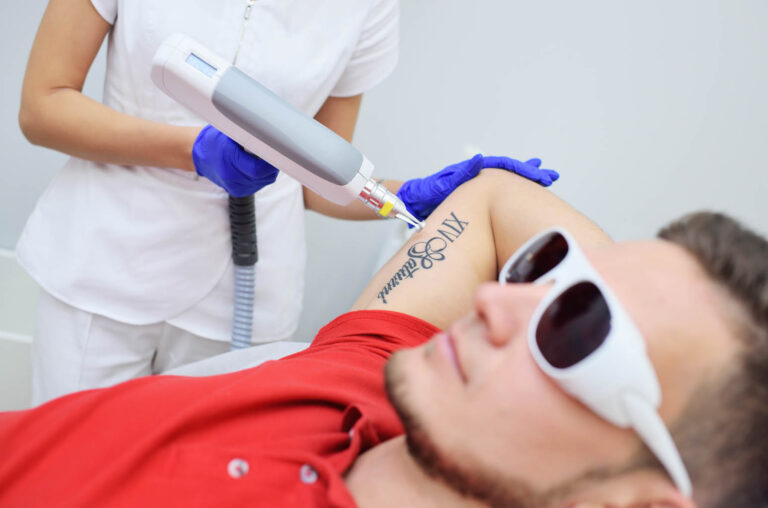What Is There to Know About Laser Tattoo Removal?
23% of Americans experience tattoo regret.
Aesthetic laser technologies have improved drastically in recent years and can be used in everything from erbium laser resurfacing to tattoo removal.
Whether it’s to get rid of the name of an ex or to revise a badly designed tattoo, laser removal is one of the safest and most effective methods to remove and lighten tattoos.
Keep reading to learn more about what laser tattoo removal is and how it works.

What is Laser Tattoo Removal?
Laser tattoo removal is considered, by far, the best way to permanently remove, revise, or lighten a tattoo.
Compared to other methods that are only questionably effective at best and can be harmful to the skin, laser removal yields better results. It only has minor, temporary side effects.
As long as the laser tattoo removal is professionally done, it is unlikely to cause scarring if you follow the proper aftercare instructions.
Laser tattoo removal is usually about as painful as getting a tattoo. It is often compared to having a rubber band snapped against your skin, meaning it is uncomfortable but tolerable.
However, if you are worried about the amount of pain caused by laser removal, most professionals will offer some form of skin numbing during the procedure.
How Does Laser Tattoo Removal Work?
In laser tattoo removal, light passes through your skin to target darker pigment colors and the skin layer between the subcutaneous and epidermis tissue. These photo acoustic lasers will make the pigment particles vibrate and create heat. This breaks down the pigment particles into smaller fragments that your white blood cells can absorb and remove.
This is typically done with Q-switched lasers, which produce powerful, brief pulses of energy. Q-switching is ideal for its ability to heat and fragment a tattoo’s ink particles without damaging the surrounding skin.
Laser removal is a gradual process, typically taking three to seven sessions to remove the tattoo fully. The number of required sessions depends on your tattoo’s:
- Age
- Size
- Coloring
- Location
These sessions are usually no longer than 30 minutes and are recommended to be at least six weeks apart to allow the skin to heal between treatments.
Size and Age
Older, smaller tattoos require fewer laser pulses than tattoos that are large and freshly inked.
Tattoos tend to lose ink density as time passes, which leads to the faded look that can occur, especially with colored ink. A lower ink density does not require as many laser pulses as a fresh, higher-density ink job, so you will not need as many sessions for complete tattoo removal.
Ink density also increases if you have layered a new tattoo on top of an old one. In such cases, you will more than likely need more than seven sessions to remove the layered tattoos.
Coloring
The coloring of your tattoo is also an important factor in how many sessions will be necessary.
In general, if you have a tattoo that is a lighter pigment than your skin tone, it will be harder to remove since the laser technology works by targeting darker pigments.
However, each color requires a specific wavelength of the laser, and some pigments are just harder to remove than others. Yellows, light greens, and turquoise tend to be more difficult to remove, and white tattoos actually cannot be removed, as they are undetectable by lasers.
Circulation
Laser removal relies on your body’s circulation to remove the ink after it has been broken down by laser technology.
Tattoos that are located in areas with low circulation will be harder to remove. This means that removing tattoos from your feet, hands, or face will be more difficult than removing tattoos located on your arms or chest.
For this same reason, it may take more sessions to remove a tattoo if you have a smoking habit. You may also need to wait longer between sessions for your skin to heal.
Laser Tattoo Removal Before and After
By the time you have undergone your last treatment session and have finished the healing process, the area that has undergone laser removal should look about the same as it did before you got your tattoo.
That being said, while laser removal causes little to no scarring, it will not be able to remove any scars that previously existed or were created during the tattoo’s application.
Also of note, laser tattoo removal is gradual, breaking up the skin’s pigment over multiple sessions to allow the body’s natural processes to remove the ink. Instead of the tattoo removal occurring immediately, the tattoo will gradually fade between sessions.
Is Laser Tattoo Removal Safe?
When done by an experienced and certified professional, laser removal is typically considered the safest way to remove a tattoo.
Laser technology tends to cause the least amount of damage, infection, bleeding, and permanent scarring. Instead, the side effects of laser tattoo removal are mild, temporary, and easily treatable.
Depending on the skill of the professional doing your tattoo removal and the coloring of your tattoo, you may experience:
- Swelling and redness
- Blistering and a mild sunburnt sensation
- Scabbing
- Itching
- Bruising and soreness
- Frosting
- Hyperpigmentation or hypopigmentation
- Scarring
The type of laser technology used also impacts the severity of side effects. At Total Family Wellness, the Alma Harmony XL Pro is used to minimize side effects and discomfort with its ICE™ simultaneous cooling technology.
Remove Your Tattoo Safely and Effectively with Laser Technology
If you are experiencing tattoo regret, laser technology is typically the best option for safe and effective tattoo removal.
As long as you get your tattoo removed by an experienced professional and follow the appropriate aftercare recommendations, the process will be safe and unlikely to leave permanent marks.
If you are experiencing tattoo regret, contact us today to schedule an appointment to get your tattoo safely removed or lightened with the Alma Harmony XL Pro.
